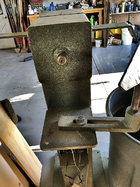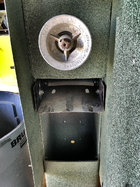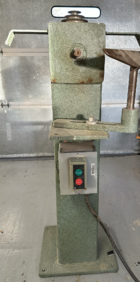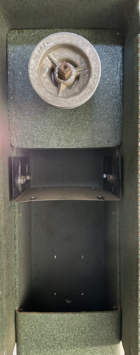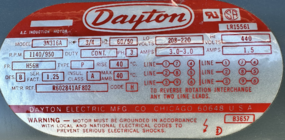-
July 2025 Turning Challenge: Turn a Multi-axis Weed Pot! (click here for details) -
Congratulations to James Seyfried for "NE Red Oak II" being selected as Turning of the Week for July 21, 2025 (click here for details) -
Welcome new registering member. Your username must be your real First and Last name (for example: John Doe). "Screen names" and "handles" are not allowed and your registration will be deleted if you don't use your real name. Also, do not use all caps nor all lower case.
You are using an out of date browser. It may not display this or other websites correctly.
You should upgrade or use an alternative browser.
You should upgrade or use an alternative browser.
Good money into bad
- Thread starter Larry Whittaker
- Start date
I think we need some more information. But I will venture to say that 3/4 hp is very low power for a lathe designed to turn bowls.
Some better images wouldn't go a miss. I am not sure what I am looking at.
Looks like a good boat anchor. I would not spend any good money to try to make something it is not.
john lucas
AAW Forum Expert
Need more info but I will agree with the others. 3/4 horse is not a good bowl lathe. It would cost quite a bit to upgrade the motor and probably not worth it unless we can see more of it to know if it's a better build.
I would ask about spindle size and maybe design. That could make a big difference. 3/4 hp is pretty minimal for a bowl lathe. How many pulleys/speed ranges does it have? Max diameter of bowl size?
robo hippy
robo hippy
I will post more pictures tonight with spec's. I don't have three phase so I was thinking of getting a motor from grizzly.I would ask about spindle size and maybe design. That could make a big difference. 3/4 hp is pretty minimal for a bowl lathe. How many pulleys/speed ranges does it have? Max diameter of bowl size?
robo hippy
Buy a cheap VFD and you can use single phase and have variable speed for your existing motor. But I would be looking for a used 2hp 3 phase motor and a new VFD. No tailstock will make some operations tougher, but not impossible.
Here's more info on this bowl lathe. It stands 3'9" tall and is 8" wide. 1" thread shaft. Two pulleys that have 3 steps on them. 3/4 in shaft that goes to threaded end. I know the 3/4 hp motor is too small so I was thinking of re-powering with a 2hp motor from Grizzly if that is feasible.
Attachments
A bowl lathe is no place to use step pulleys to change speeds. Often 25rpm can mean the difference between the lathe walking or it standing still. If you insist, it looks like you will need a new single phase magnetic start/stop switch too.
Also it has a 9" swing. Thanks for everyone thoughts. I've never had a lathe and picked this up at a surplus sale at a high school.
Wait, 9” swing, or 9” from the bed to the center? It looks like the latter, though pics can be deceiving. In tht case, the swing is 18”. If it is in fact 9” swing (4.5” from bed to center) it is, like Lyle said, a good boat anchor.Also it has a 9" swing.
9" bed to center of shaft
- Joined
- Feb 28, 2021
- Messages
- 1,662
- Likes
- 1,451
- Location
- Roulette, PA
- Website
- www.reallyruralwoodworks.com
I'd call it boat anchor as well. It just does not look anywhere near to being a complete unit - looks like a "parts unit" that was stripped down to repair other machines. If I had that laying around my shop I'd haul it to scrap yard for scrap value.
Given the casting it's built from it looks like a commercial product. I think the 9" swing is the radius, that'd be 18" diameter capacity.
A VFD for your motor will run about $150 to run it off 120V wall plugs. Rockwell Delta 12" standard duty lathes came with 3/4 hp motors and those were setup for outboard turning of bowls. Don't be too influenced by the macho motor guys. Even the Rockwell heavy duty lathes only had 1 hp motors.
Presumably it worked at one time with the existing motor.
A VFD for your motor will run about $150 to run it off 120V wall plugs. Rockwell Delta 12" standard duty lathes came with 3/4 hp motors and those were setup for outboard turning of bowls. Don't be too influenced by the macho motor guys. Even the Rockwell heavy duty lathes only had 1 hp motors.
Presumably it worked at one time with the existing motor.
Gotcha. Well, there IS something that pretty cool about it. It looks fairly heavy, albeit not a big footprint. The motor is a bit light for a bowl lathe, BUT if you are just psyched about turning and don’t mind a little bit of fixing up or motor swapping, power to you and happy turning! Not having a tailstock light make things a bit rough starting out, but if you get a chuck and also get comfortable with faceplates, I think you can have some fun. Cheers!9" bed to center of shaft
Kind of looks like the old Vega lathes. They were kind of boxy like this. Bolt it to the floor. You might be able to source a motor and phase converter locally for cheaper than you can get them from one of the lathe companies.
robo hippy
robo hippy
You could use it as a disk sander or flap sander or buffer or etc.
You can buy an import 120V VFD that can power your 3-phase motor for around $100.00 a cheap investment that you can always use
on another 3-phase machine with the same horsepower. You will have variable speed with the turn of a dial.
on another 3-phase machine with the same horsepower. You will have variable speed with the turn of a dial.
Hadn't thought about sander if it doesn't work so well as a bowl turner. I was looking at VFD's and they was showing 3HP on them wondering if they would work with the 1/2 I have? Appreciate all the input here.
- Joined
- Jan 27, 2005
- Messages
- 13,133
- Likes
- 5,628
- Location
- Dalworthington Gardens, TX
- Website
- pbase.com
Given the casting it's built from it looks like a commercial product. I think the 9" swing is the radius, that'd be 18" diameter capacity.
A VFD for your motor will run about $150 to run it off 120V wall plugs. Rockwell Delta 12" standard duty lathes came with 3/4 hp motors and those were setup for outboard turning of bowls. Don't be too influenced by the macho motor guys. Even the Rockwell heavy duty lathes only had 1 hp motors.
Presumably it worked at one time with the existing motor.
The old Delta lathes used either stepped pulleys or a mechanical variable speed pulley which meant that the only power loss was in the efficiency of the drive train. Using an inverter, on the other hand, means that there will be a substantial power penalty at slower speeds and that is the reason lathes with inverter drives use larger HP motors. It has nothing to do with your snarky "macho motor guys" remark. Keep your comments civil.
Here I am thinking that it only counts as a macho motor if it’s a custom 5hp kit lolol
IMO it would not be a set up to learn on. A big part of learning is mounting cut blanks between centers (cant be done w/o tailstock) and moving center positions to get the desired outcome. Starting between centers is typically used by experienced turners as well.
Appears to be welded from substantial square tube and plate, but being supported by a single column it will shake appreciably with out of balance work.
Good for production turning of rounded, balanced blanks. If you have room to stuff in a corner for a few years, keep it. As your turning journey progresses and you learn more, you might figure out what to do with it. As mentioned it could be used for mounting buffs or other things that dont necessarily need the expense of var speed. The common lathes most of us have look the way they do, and made the way they are for good reasons, and this one does not fit the bill.
Appears to be welded from substantial square tube and plate, but being supported by a single column it will shake appreciably with out of balance work.
Good for production turning of rounded, balanced blanks. If you have room to stuff in a corner for a few years, keep it. As your turning journey progresses and you learn more, you might figure out what to do with it. As mentioned it could be used for mounting buffs or other things that dont necessarily need the expense of var speed. The common lathes most of us have look the way they do, and made the way they are for good reasons, and this one does not fit the bill.
Woodturning with a lathe setup basically costs for equipment, time to develop skills, and fellowship. The fellowship costs nothing as time = money does not apply. Carving has much less setup costs and many employ it with turning.
Thanks for your thoughts. The question now would be what lathe to buy without breaking the bank and would serve well in the journey as skill improves.IMO it would not be a set up to learn on. A big part of learning is mounting cut blanks between centers (cant be done w/o tailstock) and moving center positions to get the desired outcome. Starting between centers is typically used by experienced turners as well.
Appears to be welded from substantial square tube and plate, but being supported by a single column it will shake appreciably with out of balance work.
Good for production turning of rounded, balanced blanks. If you have room to stuff in a corner for a few years, keep it. As your turning journey progresses and you learn more, you might figure out what to do with it. As mentioned it could be used for mounting buffs or other things that dont necessarily need the expense of var speed. The common lathes most of us have look the way they do, and made the way they are for good reasons, and this one does not fit the bill.
Well, that’s a magnum loaded question. There are quite a few threads on the forum with many opinions on that subject.Thanks for your thoughts. The question now would be what lathe to buy without breaking the bank and would serve well in the journey as skill improves.
I don’t know how much you know about turning or lathes, but I’ll assume not much. I strongly recommend that you find at least one AAW chapter/club to visit. Most clubs are happy to have visitors asking lots of questions. Learn about lathes, terminology, processes for different projects (bowls, hollow forms, platters, spindle work - whatever you are interested in), and determine the largest size you think you might make, swing and length. This will drive the size lathe to look for. Budget is as big a driver as anything as well. Expect to spend $1500-$2000 on tools, sharpening, chucks, misc accessories in addition to the lathe.
Its no different then buying a car, a flat ww tool, or anything else - the better the user can define the “mission” or job for the device, the better the choice will meet expectations.
Nothing wrong with hunting for a used lathe, but you need to have an idea of what you are looking at to evaluate it - experienced club members can be a big help.
Last edited:
Utah has some good clubs and craft supplies is just south of a salt lake city, while craft supplies only sells new in their catalog, they do offer classes, which are important for safety and general techniques for a new turner....dust is very dangerous
Think about the situation. You already have a lathe that appears to be well made (it isn't a boat anchor by any stretch of the imagination). You have the motor, 3/4 hp 3 phase. 3/4 hp was pretty much the standard for home shop lathes. All you need is 3 phase power.Thanks for your thoughts. The question now would be what lathe to buy without breaking the bank and would serve well in the journey as skill improves.
There are a few ways to get 3 phase, static converter which de-rates motor hp, rotary converter or VFD. Somebody mentioned a VFD could be purchased as low as a hundred bucks. You have a 3 step pulley, you don't have to vary the frequency so it should give you full hp at any step. Don't worry about the lack of hp, I would bet there have been far more bowls turned on step pulley, 3/4 hp lathes in the last century than on VFD lathes.
If a hundred bucks is more than you want to spend there's a simple way to build a rotary converter. Get a used 3 phase motor, maybe 1 hp or less at a scrap yard or Craigslist. Surplus 3 phase motors are usually plentiful, cheap, sometimes free. Wire two of the motor leads to 220V single place (like from your clothes dryer circuit). Wrap a rope around the motor shaft and pull like you do on an outboard motor. If you pull quick enough the motor will continue to spin at rated rpm. 3 phase will come off the motor leads. Bingo... you have a rotary converter for the cost of an old motor. This is an old trick mostly used by people who don't want to spring for the price of a factory made rotary converter.
You must have been interested in turning bowls so how better to learn bowl turning than on a bowl lathe? Maybe not the best setup, it should give you enough experience to know if you want to continue the hobby. For sure, if you decide to continue turning after this lathe you will break the bank at some point.
I am speaking as some one who has restored three vintage Oliver lathes: a 167, a 159 and a 2159. The newest one was a 1963 vintage. All are 3 phase with Reeves drive mechanical variable speed control and all are run using VFDs to generate 3 phase power from single phase 240 volt power. This provides infinite speed control with no loss of torque. I turn daily on the 2159 which has a 1 hp motor and originally had a 14 inch swing. I have modified it to 18 inches of swing. One horse power is plenty of power if one is not enamored of hogging off material a breakneck (and sometimes tooling) speed.
Your first task is to research the machine that you have acquired. If your initial cost was low enough, you should be able to purchase a VFD (variable frequency drive) to control the motor that you currently have. You will not be able to purchase a new lathe comparable to what you may have now for that price. The VFD will also function as your magnetic/safety on/off switch. For a truly modest additional cost, a wired remote control will provide your on/off switch, a potentiometer for speed control and maybe even reversing of the motor.
If you really want help deciding what to do with this lathe, post more pictures. Somewhere on the machine should be a manufacture's plate. the motor should have a data plate attached to it.
And finally, I saw nothing at all "snarky" or uncivil about the "macho motor motor guys" comment. Even modern lathes use high low ranges switched by changing belt positions to mitigate torque loss. That lathe was engineered for a 3/4 hp motor spinning an 18" blank. Learn to use the machine the way it was designed to be used. If you find that you must have a larger, more powerful motor, buy a used motor and a new VFD. To paraphrase Spiderman's uncle, "With great power comes the potential to more spectacular mishaps."
And my new lathe, which is undergoing restoration, is a 1910's American Sawmill Machinery lathe complete with Babbitt bearings, wooden legs and ways, step pulley and countershaft, powered by a 3 phase motor and VFD. It will have a 22" swing and 8 feet of bed.
Your first task is to research the machine that you have acquired. If your initial cost was low enough, you should be able to purchase a VFD (variable frequency drive) to control the motor that you currently have. You will not be able to purchase a new lathe comparable to what you may have now for that price. The VFD will also function as your magnetic/safety on/off switch. For a truly modest additional cost, a wired remote control will provide your on/off switch, a potentiometer for speed control and maybe even reversing of the motor.
If you really want help deciding what to do with this lathe, post more pictures. Somewhere on the machine should be a manufacture's plate. the motor should have a data plate attached to it.
And finally, I saw nothing at all "snarky" or uncivil about the "macho motor motor guys" comment. Even modern lathes use high low ranges switched by changing belt positions to mitigate torque loss. That lathe was engineered for a 3/4 hp motor spinning an 18" blank. Learn to use the machine the way it was designed to be used. If you find that you must have a larger, more powerful motor, buy a used motor and a new VFD. To paraphrase Spiderman's uncle, "With great power comes the potential to more spectacular mishaps."
And my new lathe, which is undergoing restoration, is a 1910's American Sawmill Machinery lathe complete with Babbitt bearings, wooden legs and ways, step pulley and countershaft, powered by a 3 phase motor and VFD. It will have a 22" swing and 8 feet of bed.
Note: the rotary converters also degrade the horse power because the odd phase is a lower voltage even on the purchased units so the VFD is the best choice. The step pulleys are a mechanical speed reduction and as such will multiply the torque while the VFD is constant torque over it's speed range so as you reduce speed the horse power is reduced.f a hundred bucks is more than you want to spend there's a simple way to build a rotary converter. Get a used 3 phase motor, maybe 1 hp or less at a scrap yard or Craigslist. Surplus 3 phase motors are usually plentiful, cheap, sometimes free. Wire two of the motor leads to 220V single place (like from your clothes dryer circuit). Wrap a rope around the motor shaft and pull like you do on an outboard motor. If you pull quick enough the motor will continue to spin at rated rpm. 3 phase will come off the motor leads. Bingo... you have a rotary converter for the cost of an old motor. This is an old trick mostly used by people who don't want to spring for the price of a factory made rotary converter.
Just like to thank all that have shared their knowledge I really appreciate it.
I understand all this Don. Yes, the VFD is the best choice, possibly the OP doesn't want to spend the money though. I've seen some pretty hokey homemade rotary converters that did the job just to save a few bucks.Note: the rotary converters also degrade the horse power because the odd phase is a lower voltage even on the purchased units so the VFD is the best choice. The step pulleys are a mechanical speed reduction and as such will multiply the torque while the VFD is constant torque over it's speed range so as you reduce speed the horse power is reduced.
Maybe we'll see what the OP wants to do.
Having the motor information, more than ever I recommend the lathe. That motor with 1140 rpm is relatively expensive as motors go and indicates the lathe may be better engineered for bowl turning than it might appear.
I converted one of my lathes from a 1725 rpm motor to 1140 rpm. Makes all the difference in the world for heavy hogging at low rpm.
I converted one of my lathes from a 1725 rpm motor to 1140 rpm. Makes all the difference in the world for heavy hogging at low rpm.
The powermatic 90 that I have had a 1HP single phase 230 volt 4 pole motor (1725 RPM) and a top spindle speed that was way beyond what I ever used. The pulley system could only be adjusted while running so I wanted to add a VFD and went to a local electrical salvage yard and found a 1 1/2 Hp 6 pole (1140RPM) 3 phase motor in a frame size that I could shoe horn into the space in to ways under the headstock. The The variable pulley system I later removed and replaced with a 2 step multi rib belt drive and the lathe is still capable of higher speeds then I ever use plus it is smoovth and quite.I converted one of my lathes from a 1725 rpm motor to 1140 rpm. Makes all the difference in the world for heavy hogging at low rpm.
In my case the 1140 rpm motor was substantially larger that the 1725 version at the same hp. There was room for it though. Note the motor in question here has a 1.25 service factor too.
With the 3 step pulley, that might be 2, 3, 4" at the lowest speed it'd be 570 rpm.
With the 3 step pulley, that might be 2, 3, 4" at the lowest speed it'd be 570 rpm.
570 rpm is faster than I want for startup for most blanks....evs has safely spoiled me
Last edited:
I didn't catch that so 1.25 X .75 (3/4 HP) = .9375 or in fractional terms 15/16 HP The service factor means you can operate continuously over the rated HP by that factor where as if the service factor is 1.00 then the continuous HP is the rated HP. Note: induction motors can operate over the continuous HP rating for short times without overheating.Note the motor in question here has a 1.25 service factor too.

